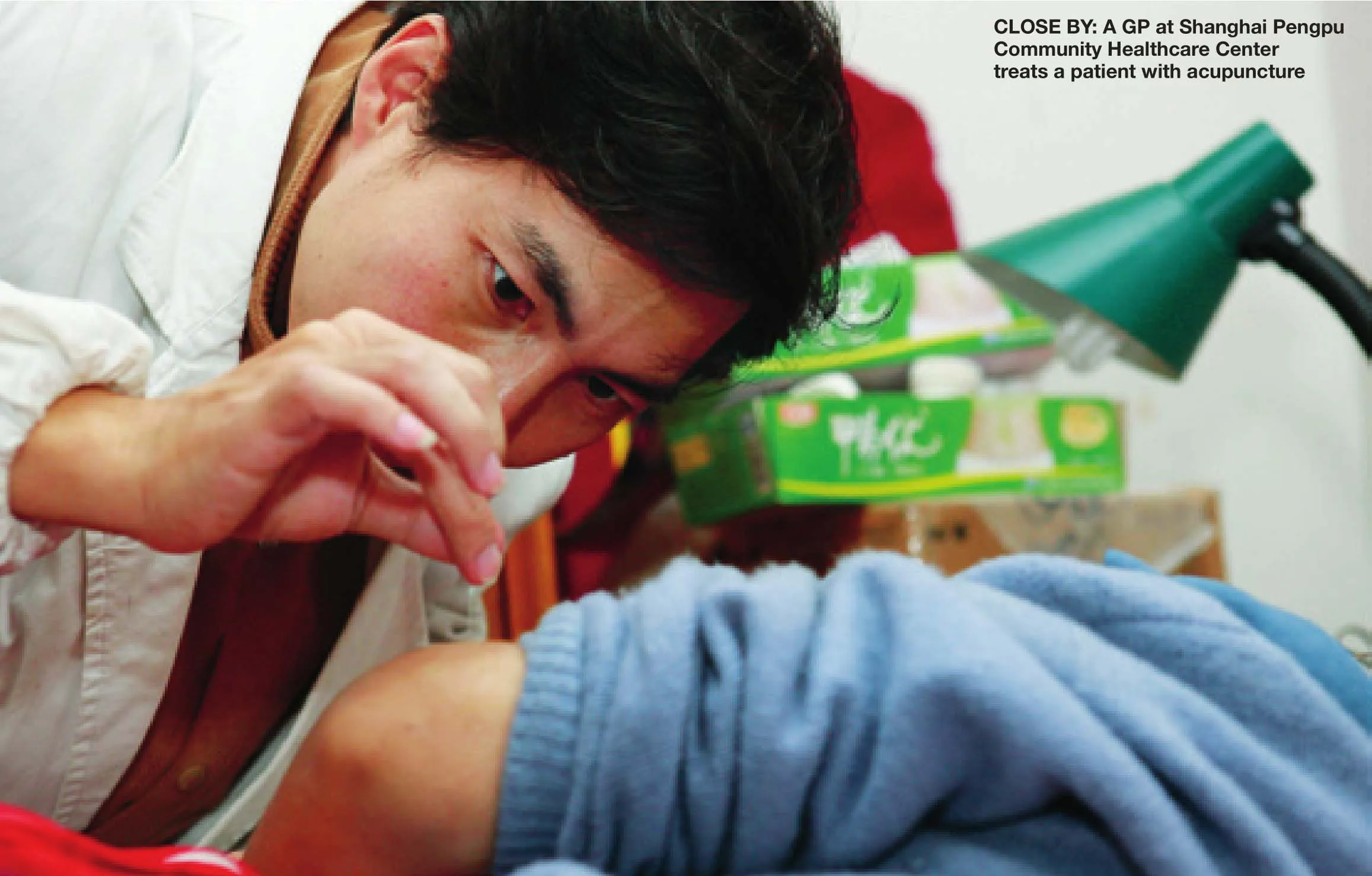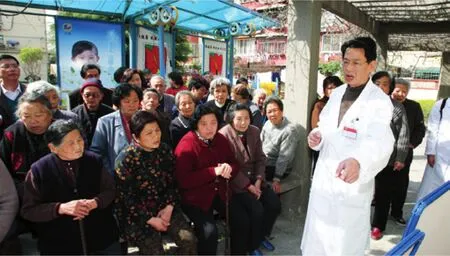Boosting a Less Known Job
2011-10-16ByYUANYUAN
By YUAN YUAN
Boosting a Less Known Job
By YUAN YUAN
General practitioners are considered key to improving public medical services D u Xueping, Director of the Yuetan Community Healthcare Center in downtown Beijing’s Xicheng District,has been involved in China’s general practitioner (GP) trial program since it began.
As an important part of the country’s medical reform, the introduction of a national GP system has been planned for almost 20 years. The Yuetan center is one of the first clinics in the country to trial the system.
“The trial program started in this center in 1994 and I came here in 1995,” said Du,who used to be a cardiovascular specialist at Beijing’s prestigious Fuxing Hospital.
“At the time, people didn’t understand why I gave up a job in a big hospital to work in a small community center,” Du said. “Even now, few people would choose to work in a community healthcare center. But based on my experience, community healthcare centers are actually more important for people’s health than big hospitals.”
A challenging choice
Community-based GPs in China mainly provide primary care, treating acute and chronic illnesses in community-level medical institutions, according to Du. They also provide preventive care for local residents.
“Cardiovascular diseases are generally urgent and severe,” Du said. “Many patients coming to me were close to death. They had to spend a lot of money on surgery and suffered a great deal. But a lot of this suffering would have been avoided if they were given proper advice and treatment from their local healthcare centers.”
Du would often give less seriously ill patients advice on how to stay healthy simply by improving their lifestyles w ith exercise and a balanced diet.
“But when giving that sort of advice, I found that in a large hospital I wasn’t able to follow up. W ithout monitoring, patients often fail to maintain a healthy lifestyle,”said Du, who believes that regular communication and contact with patients can greatly improve the effectiveness of treatment.
Du then made the decision to go to work in a community healthcare center in order to get closer to her patients. A fter the Yuetan center, which is affi liated to Fuxing Hospital,started the GP trial program, Du volunteered to work as a GP there.
“In those days, few people knew what a GP was and no medical universities in China had a major in general practice,” said Du.Beginning in 2003, she began to give classes in general practice.
Li Xiaoxiao, w ith a master’s degree in public medical healthcare, is one of Du’s students. She has worked at the Yuetan center for more than three years.
Though Li has always been considered overqualified for her job, the 27-year-old is very happy w ith her choice.
“Even if somebody offers me a much higher profile job, I won’t leave,” said Li,who concluded a one-month training at Columbia University in the United States in September. “Honestly, I’ve never given a thought to leave. I believe my workmates would say the same.”
“Compared to specialists who target specific parts of the body, GPs know more about the whole body. And since we live so close to residents, we have access to patients’families and treat the patients in a more comprehensive way,” said Gao M ing, another
“Som etim e peop le think GPs are ab le to treat on ly m ino r ailm en ts such as co lds. Ac tually the scope o f a GP’s business is very b road.”
—Zhang Yonghong, a GP at the Yuyuan Community Healthcare Center in Jinan,Shandong Province GP at the Yuetan center. “For example, if a patient suffering from insomnia goes to a big general hospital, the doctors might ask them to take some pills. Even if doctors ask for the reasons behind the insomnia, they cannot really follow up in terms of diagnosis and treatment. But a GP can visit the patient regularly and help them deal with the problem in another way.”
Lin Bo, a local resident, is a regular at the rehabilitation clinic in the Yuetan center.
“The service here is really good and it’s convenient,” said Lin, who comes to the center tw ice a week for neck problems. “When I am unable to visit the center, the physiotherapist comes to my apartment.”
“We have a record of every chronic patient in the community and visit them at home regularly. When chronic patients or elderly inhabitants need to take regular exams,we w ill call them one by one and rem ind them to come to the center,” Du said.
One-to-one services

PEI XIN
Zhang Yonghong, a GP who has worked at the Yuyuan Community Healthcare Center in Jinan, capital of eastern Shandong Province, said, “The duty of a GP is more than treating patients. It’s about being part of their life and community.”
There are about 15,000 people in the Yuyuan Community. Zhang said that her center had complete medical records for every resident there and she already recognized almost every patient who calls on her.”
Because she found quite a few of the communities’ residents were diabetic, Zhang decided to set up a club for patients of this kind. The purpose of the club is to gather diabetes patients together and then give lectures and advice on how to deal w ith the disease in daily life. They patients also share their experiences in dealing w ith the disease.
Wang Hongwei, a resident w ith diabetes in the Yuyuan Community, always goes to Zhang for problems w ith diabetes. “Once I lost weight rapidly. Initially, I thought it was because I wasn’t controlling my blood sugar very well, but Zhang told me it might be because of hyperthyreosis,” he said.
Test results confirmed that Zhang’s diagnosis was right. As a GP in regular contact w ith her patients, Zhang is often able to identify diseases at a very early stage.
“Visiting patients’ homes is another important task for GPs,” Zhang said. “The fam ily environment is very important for patients w ith chronic diseases such as high blood pressure.”
As an additional service, Zhang also answers residents’ health-related questions and gives lectures on healthcare topics.
“Sometime people think GPs are able to treat only minor ailments such as colds,”Zhang said. “Actually the scope of a GP’s business is very broad. We don’t suggest that people in emergency medical situations like heart attacks turn to us, but what we do is to prevent people from getting those urgent and severe diseases.”
Du estimates that 60 percent of ailing people don’t need to go to big hospitals.“Many patients exaggerate the symptoms of their diseases, which causes overcrow ded hospitals in large cities and waste of medical resources,” she said.
The Yuetan center’s GP trial program has been a success. Local residents now make the center their first choice for help when suffering from illnesses and often drop in at the center for various other reasons,including asking for suggestions on diet, hygiene and long-term care.
In 1996, the Yuetan center received only 2,000 patients, but the number rocketed to 210,000 in 2010.
Despite this, Du adm its the Yuetan center, as a pilot institution for training GPs,doesn’t convey a sense of the state of the GP program in other parts of China.
Challenges
“Even though the government is putting much more effort into cultivating GPs, 40 percent of current GPs still transfer to other specialities,” said Du, who believes a lack of training and low income are the main reasons professionals leave general practice.
Most of the seven GPs who work at Zhang’s healthcare center are retired doctors from general hospitals.
“Before retired doctors join us, they receive special training on being a GP, as general practice is different from the work of a specialist,” Zhang said. “The training normally lasts for months but the training content has barely changed from the time I was trained 10 years ago.”
In Shanxi, there are currently about 4,000 GPs altogether. Only a few of them, however, have passed the national GP exam.
Wang Junying has been working at the Balingqiao Community Healthcare Center in Taiyuan City, north China’s Shanxi Province, since 2007. As one of the fi rst 50 GPs in the province, Wang went through a one-year training to convert from a specialist in internal medicine to a GP.
“We spent the first two months on intense theoretical study in a medical college.We compressed lessons that should be finished in one year into two months. Then we spent another eight months in big hospitals on practice, sw itching from one department to another to become fam iliar w ith the work of different departments,” Wang said.
Wang believes, however, that the training he received wasn’t sufficient to meet the demands of general practice.
Yang Ruihong, who has worked at the Kairuiyuan Community Healthcare Center in Zibo, Shandong Province, as a GP for five years, also received sim ilar training when she sw itched from internal medicine to general practice.
“We practiced in different departments of a general hospital but I don’t think I was really qualified to be a GP after that training,” Yang said. “What we learnt from the training was just some medical know ledge that w e could learn in regular medical schools. The other aspects of being a GP,such as how to communicate w ith residents and spread medical know ledge among them were not included in the training. But I think they are very important for a qualified GP.”

SPREADING KNOWLEDGE: A GP g ives a lec tu re on the p reven tion and treatm ent o f in fec tious d iseases to residents o f Beixin jing Comm unity in Shanghai on March 27, 2006
At present, medical universities in China still focus on training specialists. Only a few universities offer students the chance to major in general practice. This means that many doctors working in community healthcare centers don’t have access to comprehensive GP training.
The Chinese Government is promoting GP training program. By 2020 the number of GPs in the country is expected to reach 300,000, which means there should be two to three GPs for every 10,000 residents.
“Some local governments m ight lower the entrance requirements to reach the number,” said Pan Zhigang, Deputy Director of the GP department of Shanghai-based Zhongshan Hospital. “But it should not be just about quantity, but also quality.”
In 2001 Shanghai set up a GP training center offering four-year training programs.Over the past 10 years, Shanghai has educated more than 4,200 GPs.
Prior to 2006 the trainees were mostly fresh graduates from medical universities who were recruited by community healthcare centers. Since 2006 the trainees are mostly selected from voluntary applicants. After the training they can choose to work as GPs at community healthcare centers.
In May 2011 Shanghai set up another institution to train GPs. Follow ing advanced evaluation and education methods from U.S.partners, the institution adopted a new fiveplus-three training method. The trainees are medical college students who spend five years at university and another three years on GP training. After eight years, the trainees are expected to have the skills they need to function as GPs.
“It takes a long time to cultivate GPs,but unfortunately the pay is not always high enough to keep them in the job,” Pan said.
“We are much busier than specialists but we get less money. I don’t think it is fair,”said Yang, who revealed her salary is about 2,000 yuan ($315) per month, not even half that of a specialist with her experience.
Du said that the GPs at the Yuetan center earned only slightly more than Yang. Worse still, community healthcare centers as a whole suffer from a deficiency of funds, as the standard for their government subsidies was set in the 1990s or even 1980s, which is far behind requirements.
“There is a real need for more GPs in China. But to realize the government’s goal to popularize general practice in communities,there is still a long way to go,” Du said.
General Prac tice in China
General practice was adopted in China in the 1990s. At present, there are roughly 130,000 GPs in the country, mainly in big and medium-sized cities.
In June 2010 an executive meeting of the State Council decided that China w ill establish a national system of general practitioners.
A statement of the meeting lists principles for establishing the new system to ensure the quality of GPs, with a focus on improving their capabilities in clinical practice, standardizing the criteria for training GPs and creating strict requirements for doctors who w ish to apply for GP certification.
China w ill work to ensure that for every 10,000 urban or rural residents, there will be two to three qualified general practitioners ready to take care of their health problems.Based on this standard, by 2020, China w ill have 300,000 GPs.
In this case, “qualified” is defined as having completed a five-year bachelor’s degree program in clinical medicine and three years of specialized medical education before becoming a general practitioner, the statement says.
many patients each day. Many of the patients traveled hours or even days from other cities and towns for treatment.
